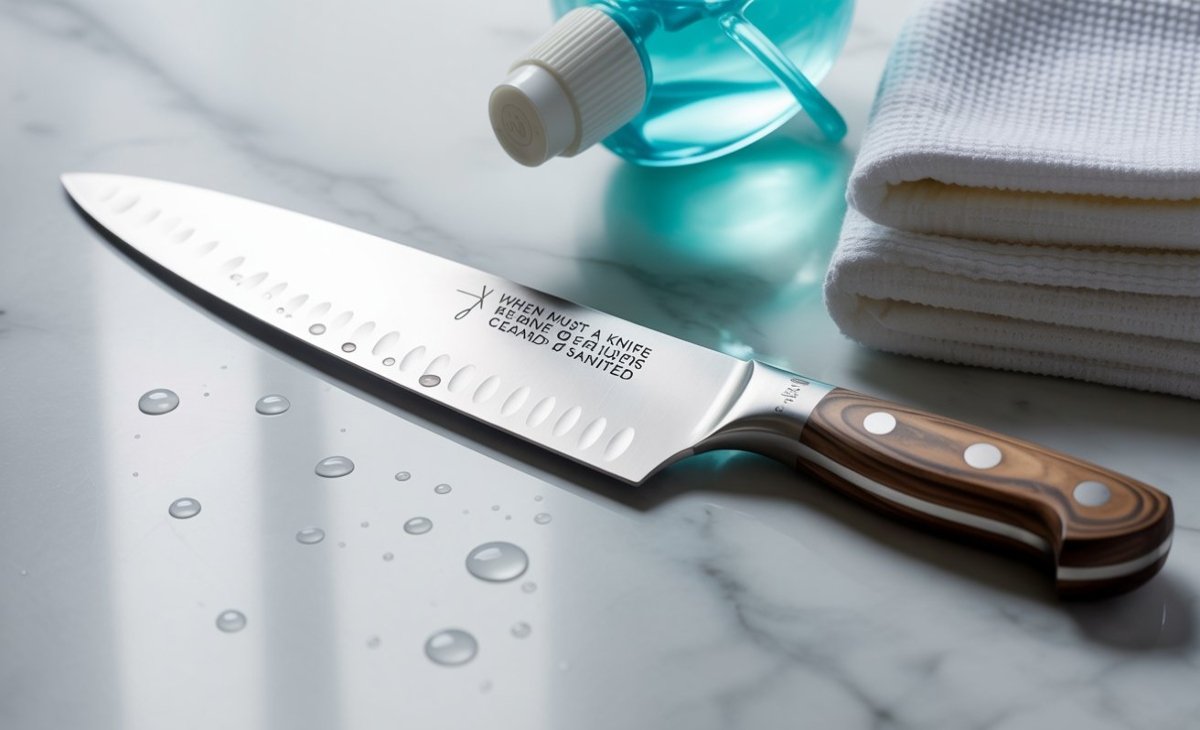Keeping your kitchen safe starts with a simple question: when must a knife be cleaned and sanitized. A clean knife protects you and your food from dangerous bacteria. In this guide, you’ll learn when, why, and how to keep your knives spotless, so you can cook with confidence every time.
Why Knife Cleaning and Sanitizing Matter
Every year, foodborne illnesses affect millions of people worldwide. The Centers for Disease Control and Prevention (CDC) estimates that about 48 million Americans get sick each year due to contaminated food. Cross-contamination is one of the leading causes—and your knife can easily spread harmful germs from one ingredient to another if it’s not cleaned properly.
When you cut raw chicken and then slice a tomato with the same knife, you risk transferring bacteria like Salmonella or E. coli onto ready-to-eat food. Cleaning and sanitizing your knife stops this spread.
Find the Latest Updates on: Deepworldinsights
When Must a Knife Be Cleaned and Sanitized
Knowing exactly when must a knife be cleaned and sanitized helps prevent these dangers. Here are the key times to clean and sanitize your knife:
1. After Cutting Raw Meat, Poultry, or Seafood
Raw animal products carry bacteria that can spread to other foods. Always wash your knife right after cutting raw meat, poultry, or seafood before moving on to other ingredients.
2. Between Different Food Types
Switching from one type of food to another? Clean your knife to avoid mixing allergens, bacteria, or unwanted flavors. For example, don’t slice bread after cutting raw fish.
3. After Peeling or Preparing Vegetables and Fruits
Many people forget this step when must a knife be cleaned and sanitized. Even fresh produce can carry harmful germs, especially if not washed well. Clean your knife after peeling potatoes, carrots, or any produce.
4. After Four Hours of Continuous Use
The USDA’s food safety guidelines recommend that tools used constantly should be cleaned and sanitized at least every four hours. This is especially important in commercial kitchens.
5. After Sharpening
Sharpening a knife leaves tiny metal shavings on the blade. Always wash and sanitize your knife after sharpening to keep metal fragments out of your food.
6. After Any Damage or Contamination
If your knife falls on the floor, touches raw waste, or is used improperly, clean it immediately. When in doubt, wash it out!
Cleaning vs. Sanitizing: What’s the Difference?
Many people think cleaning and sanitizing are the same, but they’re not.
- Cleaning removes visible dirt, food scraps, and grease.
- Sanitizing kills invisible germs that can make you sick.
Both steps are necessary for true kitchen safety.
How to Properly Clean and Sanitize a Knife
Gather Your Supplies
You’ll need:
- Warm water
- Dish soap
- A clean sponge or cloth
- A sanitizing solution (like a mild bleach mix)
Clean the Knife
Rinse immediately: Don’t let food dry on the blade.
Wash with soap and warm water: Scrub both sides, handle, and any grooves.
Rinse again: Remove all soap residue.
Sanitize the Knife
Use a safe sanitizing solution. For a bleach solution, mix 1 tablespoon of unscented liquid chlorine bleach with 1 gallon of water.
- Dip the knife blade and handle into the solution for at least one minute.
- Let it air dry completely on a clean rack.
Dry the Knife
Always dry knives with a clean towel or let them air dry. Storing a damp knife can cause rust and encourage bacteria growth.
Extra Knife Safety Tips
Don’t Use a Dishwasher
Many knives shouldn’t go in a dishwasher. High heat and harsh detergents can damage the blade, handle, and edge. Wash by hand instead when must a knife be cleaned and sanitized.
Store Knives Properly
Keep knives in a clean, dry block, magnetic strip, or sheath. Never toss knives into a drawer—they can dull quickly and pose a safety hazard.
Use Separate Cutting Boards
Pair your knife hygiene with proper cutting board use. Keep one board for raw meats and another for fruits, veggies, or bread.
Common Myths About Knife Cleaning
Myth 1: Hot Water Alone Kills Germs
Wrong. Hot water helps loosen grime, but you still need soap to lift away grease and sanitizing solution to kill bacteria.
Myth 2: Wiping with a Towel Is Enough
Not true. A quick wipe spreads germs rather than removing them.
Myth 3: If It Looks Clean, It’s Safe
Some bacteria are invisible. Even if your knife looks spotless, it can still harbor germs if not properly sanitized.
When Must a Knife Be Cleaned and Sanitized in Restaurants?
Restaurants have strict food safety rules. Professional chefs must clean and sanitize knives:
- After cutting raw foods
- Every four hours during continuous use
- Between working with different ingredients
- Any time cross-contamination could occur
These rules help keep customers safe from foodborne illness outbreaks.
Simple Checklist: Safe Knife Cleaning Habits
Clean after cutting raw meat, fish, or poultry
Sanitize after four hours of constant use
Wash after sharpening
Use soap and warm water—never skip the sanitizing step
Dry knives fully before storing
Store knives properly to prevent contamination
Final Thoughts: Keep Your Kitchen Safe
Knowing when must a knife be cleaned and sanitized is one of the simplest ways to protect yourself and your family from harmful bacteria. By building these habits into your daily routine, you’ll enjoy safer, healthier meals—without the worry of hidden germs.
FAQs About Knife Cleaning and Sanitizing
Q: Can I use vinegar instead of bleach to sanitize my knife?
A: Vinegar helps clean but isn’t a strong enough sanitizer on its own. Use a proper sanitizing solution for best results.
Q: Is it OK to soak knives?
A: No. Prolonged soaking can damage the blade and handle. Wash promptly instead.
Q: What’s the safest way to dry a knife?
A: Air drying is best. Or use a clean, dry towel, wiping away from the blade to avoid cuts.


